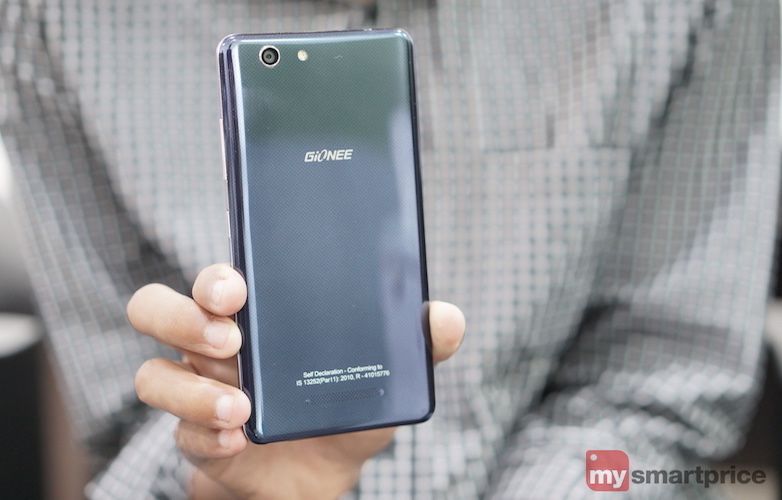
Gionee, the Chinese multinational smartphone company, introduced two new smartphones to its popular Elife series – a big and sturdy Elife E8 and a sleek Elife SPlus. At the time of its launch in November 2015, the company’s CEO said that the Elife SPlus was made exclusively keeping the Indian consumers in mind.
The SPlus marks Gionee’s first smartphone to have a Type-C port in the under-Rs.20,000 price category. In this aspect, the phone faces competition from devices such as the LeEco Le 1S and the Redmi Note 3.
Other specifications include a 5.5-inch display, 13-megapixel rear shooter, and 3,150mAh battery. It also has a set of interesting features such as Immersive Touch and Magic Vibration. The device comes preloaded with Amigo 3.1 UI based on Android 5.1.1 Lollipop.
Gionee has made the SPlus available both in the offline as well as online market. The device comes in three colour variants, namely, dark blue, gold, and white. We got our hands on a blue coloured variant of the device and here’s our account of the same.
Design
It is only in the recent past that Gionee started focussing on the design aesthetics of its smartphones as its previously released smartphones were known to focus only on one aspect – the Elife series focussed on a slim design whereas the Marathon series focussed on a long battery life.
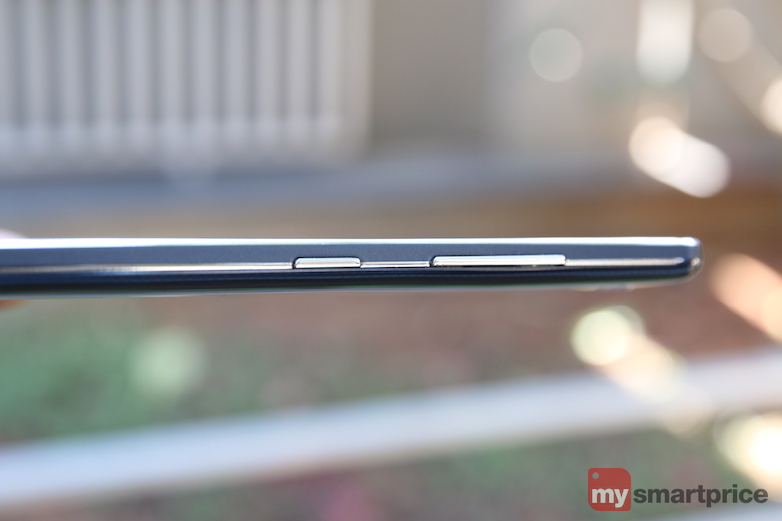
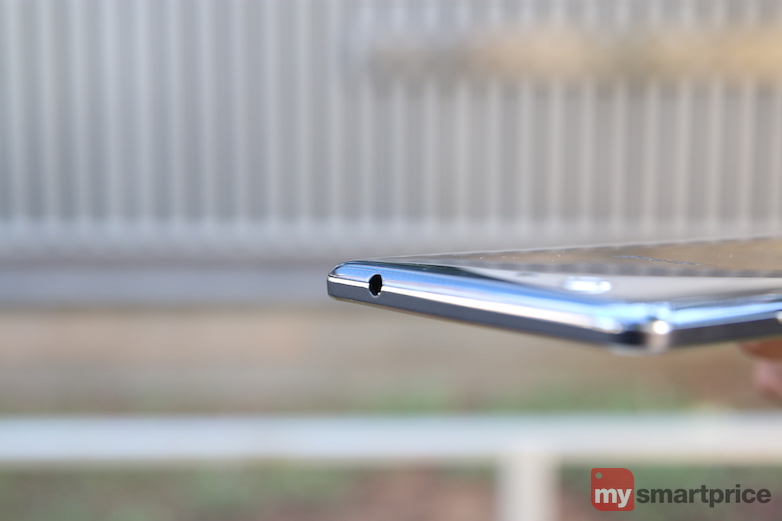
The placement of the ports is ideal – the volume and the power buttons are placed on the right edge, the 3.5mm jack is placed at the top, and the Type-C Micro-USB slot, along with a microphone, is located at the bottom. Flip the phone to its rear, and you will find the camera module accompanied by an LED flash. At the bottom, there is the loudspeaker. The back panel has a diamond pattern on it and is removable. Underneath the panel you have the non-removable 3,150mAh battery, two SIM card slots and a microSD card slot. It’s astonishing to see how Gionee managed to fit a 3150mAh battery inside a device that is only 7.5mm thick.
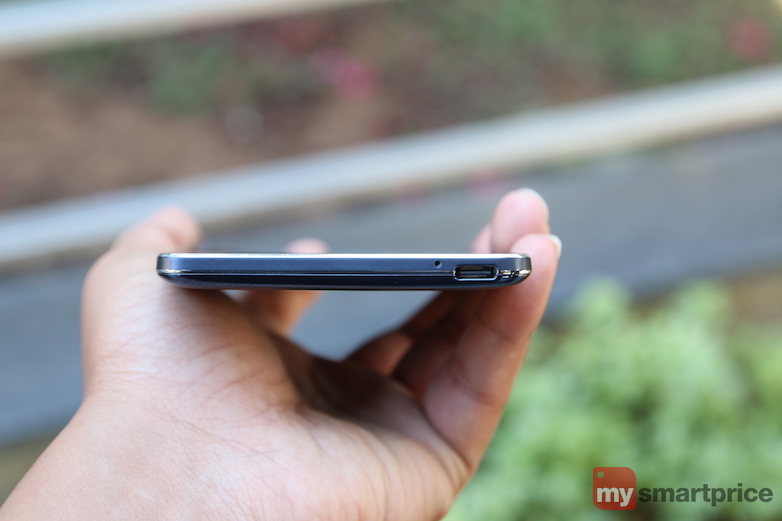
Display
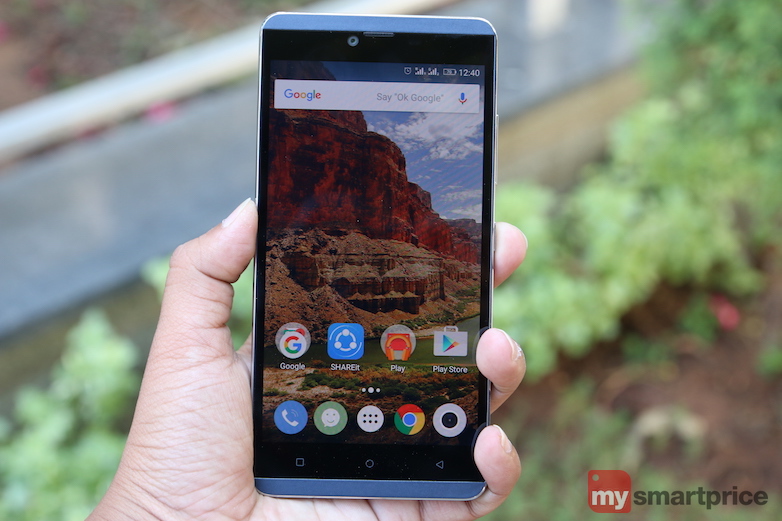
Hardware
Gionee offers a similar hardware configuration as the Marathon M5 in the SPlus. The device houses a 64-bit octa-core Mediatek MT6753 chipset, along with 3GB of LPDDR3 RAM. This chipset has eight ARM Cortex-A53 processing cores, all of which are clocked at 1.3GHz. The chipset is integrated with Mali-T720MP3 GPU for the graphics.

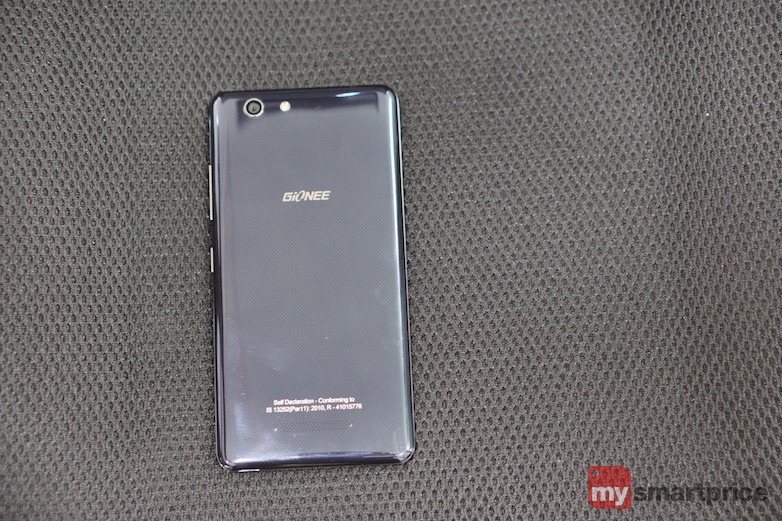
Software and apps
The SPlus boots Android 5.1.1 Lollipop with Gionee’s custom ROM, Amigo 3.1, on top of it. Amigo OS is a heavily skinned UI with no traces of stock Android. We’ve noticed lately that many Android skins have been doing away with the app drawer. That could most likely be because people have been reacting positively to this trend. However, you can always use the Google Now launcher or other third party launchers available on Google Play Store.
Gionee offers a number of apps such as Chameleon and Amigo Paper on the SPlus that allow you to personalise the look of the interface. The Chameleon app uses the camera to detect colours from your surroundings and customises the theme with these corresponding colours and the Amigo Paper app gives you access to a number of wallpapers. Amigo UI has its own theme engine called Theme Park. However, these themes work only with the stock launcher.
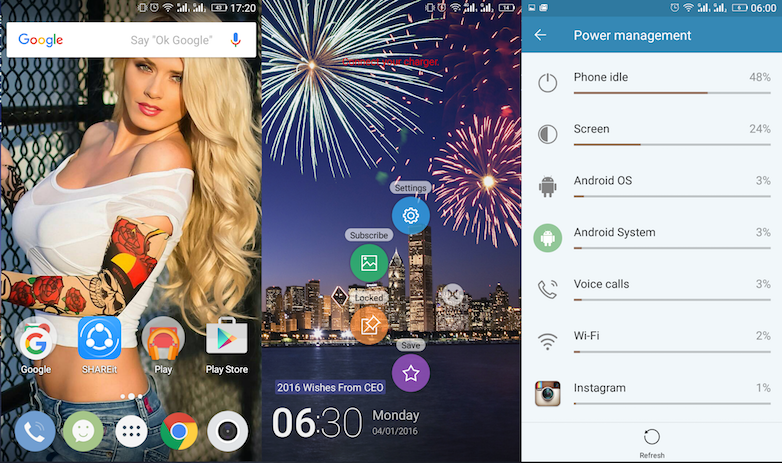 Like many Chinese custom skins, Amigo UI seems to be inspired by Apple iOS. The Notification Centre is the same as on iOS, but interestingly this phone allows you to choose the notification priority, which means that you can choose the apps whose notifications you want to see first. Swiping upwards from the home screen displays the Control Centre which gives access to quick settings like Wi-Fi, Bluetooth and Touch. We found using Control Centre on this device to be very cumbersome, as on more than one occasion we accidentally ended up pressing the capacitive buttons instead.
Like many Chinese custom skins, Amigo UI seems to be inspired by Apple iOS. The Notification Centre is the same as on iOS, but interestingly this phone allows you to choose the notification priority, which means that you can choose the apps whose notifications you want to see first. Swiping upwards from the home screen displays the Control Centre which gives access to quick settings like Wi-Fi, Bluetooth and Touch. We found using Control Centre on this device to be very cumbersome, as on more than one occasion we accidentally ended up pressing the capacitive buttons instead.
The device comes preloaded with many applications and games such as Spiderman, Danger Dash, Bubble Bash Mania, Xender, and WPS office. While these occupy a lot of the storage space, one can uninstall them to free memory space. Gionee’s lock screen comes with an Immersive Touch feature which is similar to Apple’s 3D-Touch. We noticed that this worked only from the lock screen. By long-pressing the display on the lock screen, you get options such as ‘save the current lock screen’, ‘subscribe for a particular lock screen wallpaper package’ and ‘lock the current wallpaper’.
The frequently accessed options i.e Display, Sound, Notifications and Control Centre can be accessed from the Settings app. The rarely used ones such as Smart Gestures, Black Screen gestures, LED light settings and App permissions can be accessed from the Advanced Settings menu. There is also an LCD Effect feature in the Display menu which allows you to customise the screen’s colour from neutral, cool and warm options. There is no ‘clear all’ button to dismiss the recently opened applications and one has to swipe them individually which is inconvenient.
Overall, while Amigo UI has improved a lot, we feel that it needs some more work in certain aspects such as the lock screen, which was buggy most of the time.
Camera
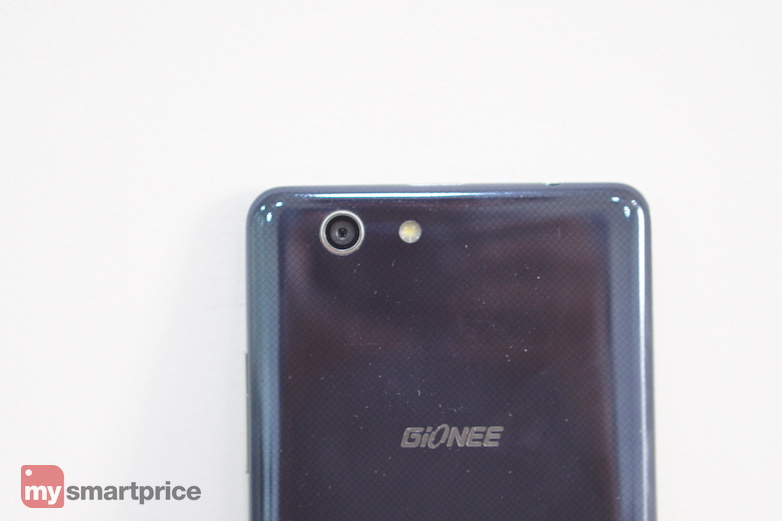
 Images taken in daylight are detailed and crisp. The colours are close to accurate and there is no noise in them either. Colour reproduction and saturation is well-handled by the rear image sensor. However, we experienced delay in focusing while shooting macro shots. In contrast, the device struggles to produce the same result in low light. Images are on the warmer side and have a lot of noise and distortion in them.
Images taken in daylight are detailed and crisp. The colours are close to accurate and there is no noise in them either. Colour reproduction and saturation is well-handled by the rear image sensor. However, we experienced delay in focusing while shooting macro shots. In contrast, the device struggles to produce the same result in low light. Images are on the warmer side and have a lot of noise and distortion in them.
 The rear camera is capable of recording videos up to 1080p. An anti-shaking feature helps in removing shakes from videos. The front-facing camera has a 5-megapixel sensor. Images captured by the front camera are detailed and have accurate colours.
The rear camera is capable of recording videos up to 1080p. An anti-shaking feature helps in removing shakes from videos. The front-facing camera has a 5-megapixel sensor. Images captured by the front camera are detailed and have accurate colours.
 The camera app offers a variety of shooting modes such as Magic Focus, HDR, Panorama, Night, Take Anytime (burst mode), and Ultra pixel. There is also a professional mode that offers control over settings such as Focus, Shutter Speed, White Balance, ISO and Exposure Value. We liked the Ultra Pixel mode, which was introduced in the Elife E8. The Ultra Pixel mode produces an image in 120p by basically combining five images together. However, images take nearly 20 seconds to process and the image size is almost 20MB.
The camera app offers a variety of shooting modes such as Magic Focus, HDR, Panorama, Night, Take Anytime (burst mode), and Ultra pixel. There is also a professional mode that offers control over settings such as Focus, Shutter Speed, White Balance, ISO and Exposure Value. We liked the Ultra Pixel mode, which was introduced in the Elife E8. The Ultra Pixel mode produces an image in 120p by basically combining five images together. However, images take nearly 20 seconds to process and the image size is almost 20MB.
The Camera on the SPlus is a bit of a let down when compared to the camera modules on another device like the OnePlus X and Moto X Play which offer a better imaging experience.
Audio and Video
The device comes with a default app for playing music and video files. This app consists of a grid-based circular interface with buttons to navigate between the various categories of music such as songs, artists, folders and favourites. The device also supports fancy gestures like ‘shake to change song’. There is also the option to display the lyrics on your screen. The music player can play the usual .mp3 files as well as FLAC files without any issues. The Equaliser gives you the option of choosing from either pre-tuned device settings or from a list of presets such as Classic, Dance, Folk, Heavy Metal and Jazz. The device also offers you a variety of modes when you plug-in the earphones such as Standard Headset, Ears Headset, Earphone, Headset, and Soundbox for multi-channel sound experience. Sound through the speaker is loud and crisp.
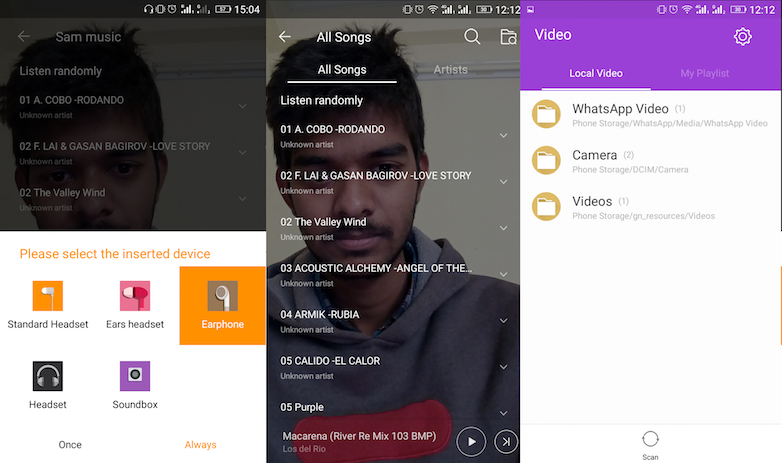 The video app supports different types of formats such as .mp4 and .mkv and plays all formats in HD. In our video loop test, the device played videos at 30fps and 60fps without any hiccups. However, every time we moved forward/backward into the video, we noticed a lot of lag. This was something unusual that we came across, as on other devices like the OnePlus X and the Moto X Play, we’ve always had a much more smooth experience.
The video app supports different types of formats such as .mp4 and .mkv and plays all formats in HD. In our video loop test, the device played videos at 30fps and 60fps without any hiccups. However, every time we moved forward/backward into the video, we noticed a lot of lag. This was something unusual that we came across, as on other devices like the OnePlus X and the Moto X Play, we’ve always had a much more smooth experience.
Performance
The combination of a Mediatek MT6753 SoC with 3GB of RAM is proof enough that the SPlus will perform well in real-life scenarios. The phone does well in terms of web-browsing – there were no shutters or frame drops. Games also run pretty smoothly, all thanks to the Mali-T720MP3 GPU. We played Riptide GP2, Beach Buggy Racing and Mortal Combat 5, the experience of which was fun and smooth. However, we noticed that after a period of approximately 20 minutes, the device would heat up.
Multitasking on this phone is quite satisfactory as well. This was the case even after using a number of apps, which is a good thing. Amigo UI is responsive, for the most part, with no lags. The user experience on the stock launcher is also pretty smooth.
 In terms of call quality, the SPlus has no issues, and we noticed that the device can hold on to cellular networks quite well. Wi-Fi reception on the SPlus is good too. But, the lack of dual-band Wi-Fi is felt as other manufacturers offer dual-band at this price range.
In terms of call quality, the SPlus has no issues, and we noticed that the device can hold on to cellular networks quite well. Wi-Fi reception on the SPlus is good too. But, the lack of dual-band Wi-Fi is felt as other manufacturers offer dual-band at this price range.
In terms of benchmarks, the device scored 2,852 in the Vellamo browser test, which ranks the device slightly above the OnePlus X. In the AnTuTu benchmark test, the device scored 35,100, which is good, especially considering the price range the SPlus falls in. We also ran the device through the T-Rex HD 1080p Offscreen test in which it scored19fps in the GFXBench suite (which tests the gaming power of a device). These benchmark results indicate that this phone is as competent as the OnePlus X. That apart, the SPlus has great overall performance and it looks like the OS has been well-optimised.
Battery Life
The device packs a 3,150mAh battery and offers a screen-on time of about five hours. During our time with the device, we installed over 70 apps and games, most of which required to be connected to the internet. We played games for several hours with multiple apps running in the background simultaneously, browsed the web for a while, made a number of voice calls, and also used messaging applications like WhatsApp and Facebook intermittently. On this kind of usage, the device lasted for about 33-36 hours. That said, the results changed when the device was connected to LTE – the screen-on time decreased by about an hour. Moreover, the phone would get warm on continuous LTE connectivity i.e while browsing the web or using shopping apps.
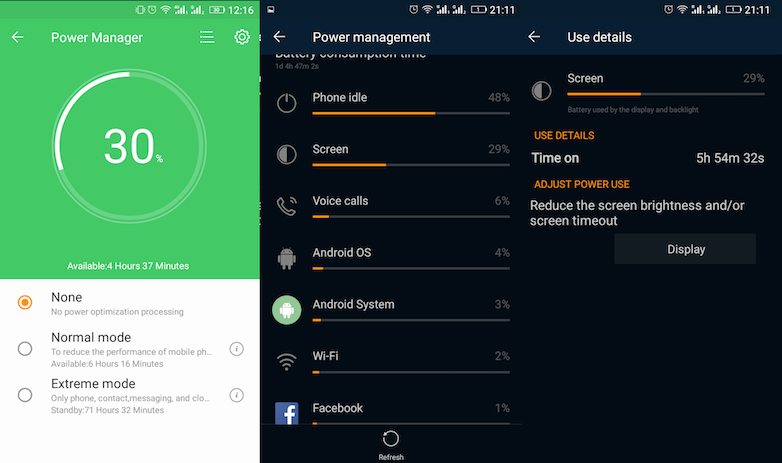 The device offers two battery saving modes – Normal and Extreme. The Normal mode optimises several functions such as lowering the brightness, decreasing the sleep time of the display and changing the UI to black. The Extreme mode, on the other hand, enables only four functions namely phone, messaging, contacts and clock. In a nutshell, the battery life of the SPlus is much better when compared with that of devices like the OnePlus X and the Moto X Play.
The device offers two battery saving modes – Normal and Extreme. The Normal mode optimises several functions such as lowering the brightness, decreasing the sleep time of the display and changing the UI to black. The Extreme mode, on the other hand, enables only four functions namely phone, messaging, contacts and clock. In a nutshell, the battery life of the SPlus is much better when compared with that of devices like the OnePlus X and the Moto X Play.
Conclusion
The Gionee SPlus packs competitive hardware in a beautifully designed handset. What it lacks in its camera (it fails to capture good images in low light), it effectively makes up for it in other aspects. Moreover, the display allows 30fps and 60fps videos to run without any lag or stutter. Performance of the device is also good, thanks to the optimised Amigo UI.
The device’s closest rivals are the OnePlus X and the Motorola Moto X Play. Both these devices offer a good display and a good camera but struggle in terms of battery life. Available at a price of Rs.16,500 on Amazon India and Flipkart, the Gionee SPlus offers you a good battery life and good multimedia capabilities. The device is clearly a handset made for the power users and multimedia enthusiasts out there.














